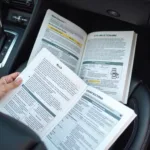Knowing What Car Service To Do In 12 Months is crucial for maintaining your vehicle’s performance, safety, and longevity. Regular maintenance not only prevents costly repairs down the road but also ensures a smooth and reliable driving experience. This guide provides a comprehensive overview of the essential car services you should consider within a 12-month period.
Understanding the specific needs of your car based on its make, model, and mileage is paramount. While this guide offers a general framework, always refer to your owner’s manual for manufacturer-recommended service intervals. Additionally, driving conditions and habits can influence the frequency of certain maintenance tasks. For example, frequent city driving or driving in harsh weather may necessitate more frequent servicing than highway driving in moderate climates. what includes jn car servicing can offer a good starting point to understanding car service basics.
Essential Car Services within 12 Months
A 12-month car service schedule typically includes a combination of routine checks, replacements, and inspections. These services can be categorized into essential maintenance and preventative measures.
Routine Checks and Replacements
- Oil and Filter Change: Perhaps the most fundamental car service, changing the oil and filter every 3,000-5,000 miles (or as recommended by your owner’s manual) is vital for engine health. Fresh oil lubricates engine components, reducing friction and wear.
- Air Filter Replacement: A clean air filter ensures optimal airflow to the engine, improving fuel efficiency and performance. Inspect and replace the air filter every 12,000 miles or as needed.
- Cabin Air Filter Replacement: This filter cleans the air entering the cabin, protecting you from dust, pollen, and other pollutants. Replacing it annually or as needed enhances air quality inside your vehicle.
- Wiper Blade Replacement: Worn-out wiper blades compromise visibility, especially during inclement weather. Replace them every 6-12 months or when they show signs of deterioration.
Preventative Maintenance and Inspections
- Brake Inspection: Brakes are critical for safety. Inspect brake pads, rotors, and calipers for wear and tear. Brake fluid levels should also be checked and topped off if necessary. Consider how often should you have your car serviced for brake-specific recommendations.
- Tire Rotation and Balancing: Rotating tires ensures even wear and prolongs their lifespan. Balancing prevents vibrations and improves handling. Generally, tire rotation and balancing are recommended every 5,000-7,500 miles.
- Battery Check: A weak battery can leave you stranded. Have your battery tested regularly to ensure it’s holding a proper charge. how to service a dead car battery can guide you on battery maintenance.
- Coolant System Flush: Flushing the coolant system removes rust and deposits, preventing overheating and extending the life of the engine. Consult your owner’s manual for the recommended flush interval.
## What Car Service to Do in 12 Months: Addressing Common Concerns
What if I don’t drive my car very often? Even if your car isn’t driven frequently, certain fluids can deteriorate over time. It’s essential to follow the time-based service intervals outlined in your owner’s manual, regardless of mileage.
Can I perform some of these services myself? While some basic tasks, like checking fluids and replacing wiper blades, can be done at home, more complex procedures are best left to qualified technicians.
“Regular maintenance is an investment, not an expense,” says John Smith, Senior Automotive Technician at AutoCare Experts. “Catching potential issues early can save you significant money and hassle in the long run.”
Conclusion
Understanding what car service to do in 12 months is crucial for maintaining your vehicle’s health, performance, and safety. By following a regular maintenance schedule and addressing potential issues promptly, you can ensure a smooth and reliable driving experience for years to come. For further insights into car servicing frequency, check how often to service car. Remember, consulting your owner’s manual and seeking professional advice when needed are key to responsible car ownership. Remember, proactive maintenance is always better than reactive repairs.
FAQ
- How often should I change my car’s oil? Every 3,000-5,000 miles or as recommended by your owner’s manual.
- What is involved in a brake inspection? Checking brake pads, rotors, calipers, and fluid levels.
- Why is tire rotation important? It promotes even wear and extends tire lifespan.
- How often should I have my car serviced? Consult your owner’s manual for specific recommendations.
- What can I do to extend my car’s battery life? Regular testing and ensuring proper charging.
- What are the signs of a failing battery? Difficulty starting, dimming headlights, and clicking sounds.
- Why is preventative maintenance important? It prevents costly repairs and ensures optimal performance. You may also want to see what all is involved in the service of a car what all is involved in service of a car i for further details.
Need help? Contact us via WhatsApp: +1(641)206-8880, Email: [email protected]. We have a 24/7 customer support team.


